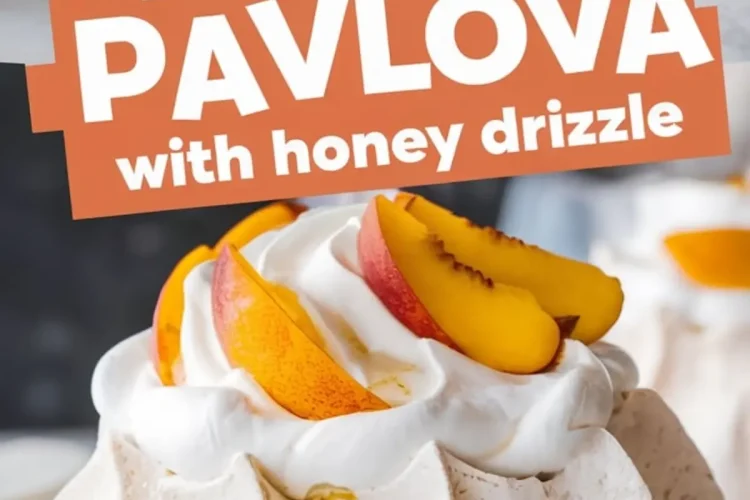This Peach Pavlova isn’t delicate in the way most meringues are. It’s structured, full of contrast, and relies more on attention than precision. The edges crack a little, the center sinks just enough to welcome the cream. The sweetness doesn’t hit hard—it unfolds slowly with each bite, thanks to the soft fruit and floral honey.
You’ll learn how to make a crisp, cloud-like meringue with a marshmallow-soft center, how to whip cream so it complements rather than overpowers, and how to layer ripe peaches with honey to get the most flavor out of both. This recipe doesn’t chase perfection. It builds confidence with simple steps and familiar ingredients that shine in the right balance.
I started making pavlovas after failing miserably at sponge cakes during a humid July in my first apartment. My oven barely held its temperature, but somehow, meringue came out just right. I learned quickly that low and slow was more forgiving than high and fast, and that peaches belonged in more than pies.
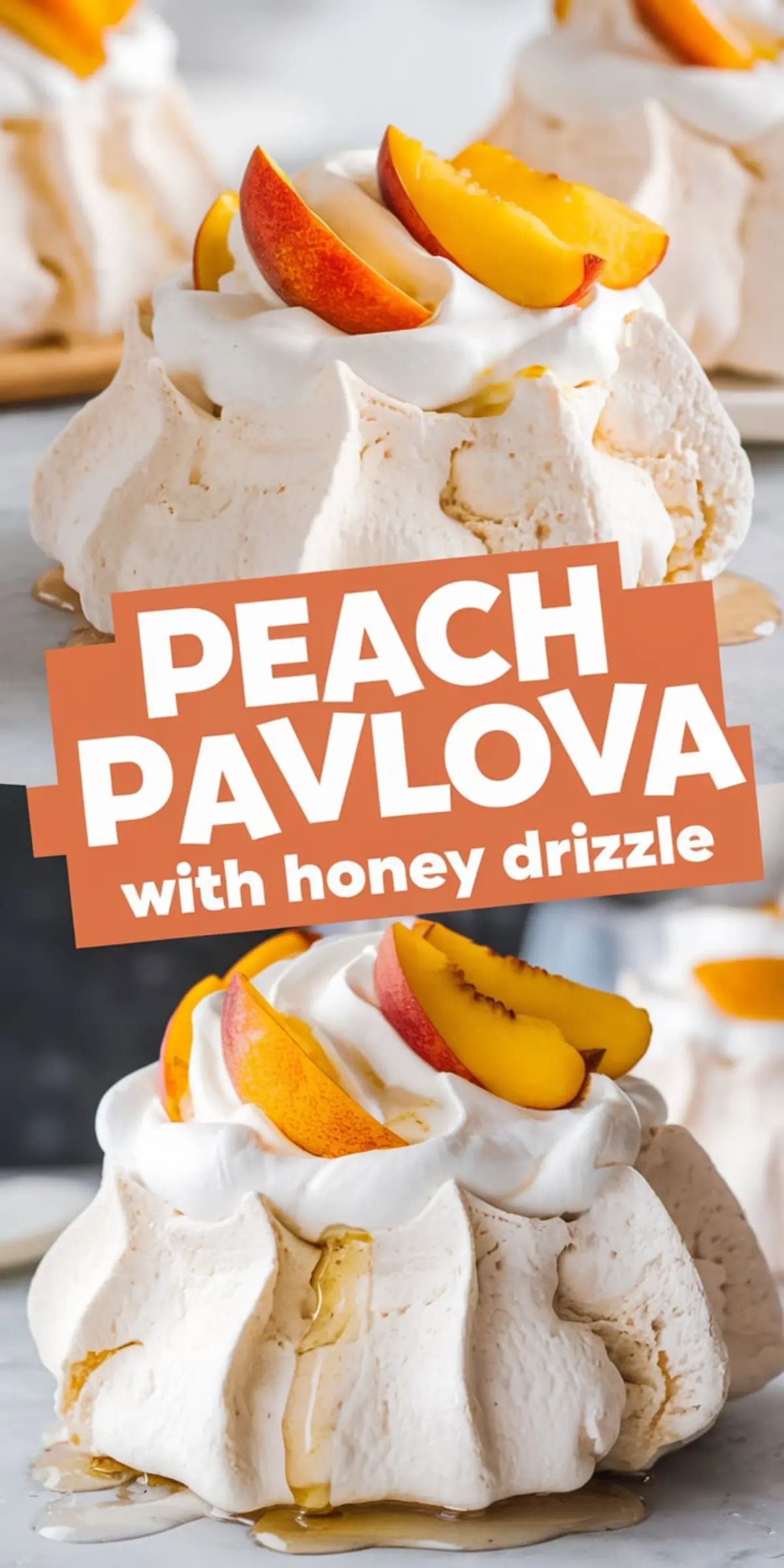
How to Make the Meringue Base for a Pavlova with Crisp Edges and Soft Center
Egg whites at room temperature beat fuller and stronger. If they’re cold, they resist the volume you need. I let mine sit out while prepping the tray and sugar.

Whipping egg whites to soft peaks gives you structure without stiffness. Then comes the caster sugar—fine enough to disappear into the foam without turning it grainy. Add it slowly, one spoon at a time. The mixture turns glossy and thick, like marshmallow cream that holds its shape.
Once you’ve folded in the cornstarch, vinegar, and vanilla, the texture changes slightly—it becomes more stable. It should still be airy, but now it holds. I like to shape mine using an offset spatula, creating slightly raised edges so the filling doesn’t slip off later. The swirls and peaks will brown lightly in the oven and catch just enough attention without needing decoration.
Baking Tips for a Pavlova That Doesn’t Crack or Collapse
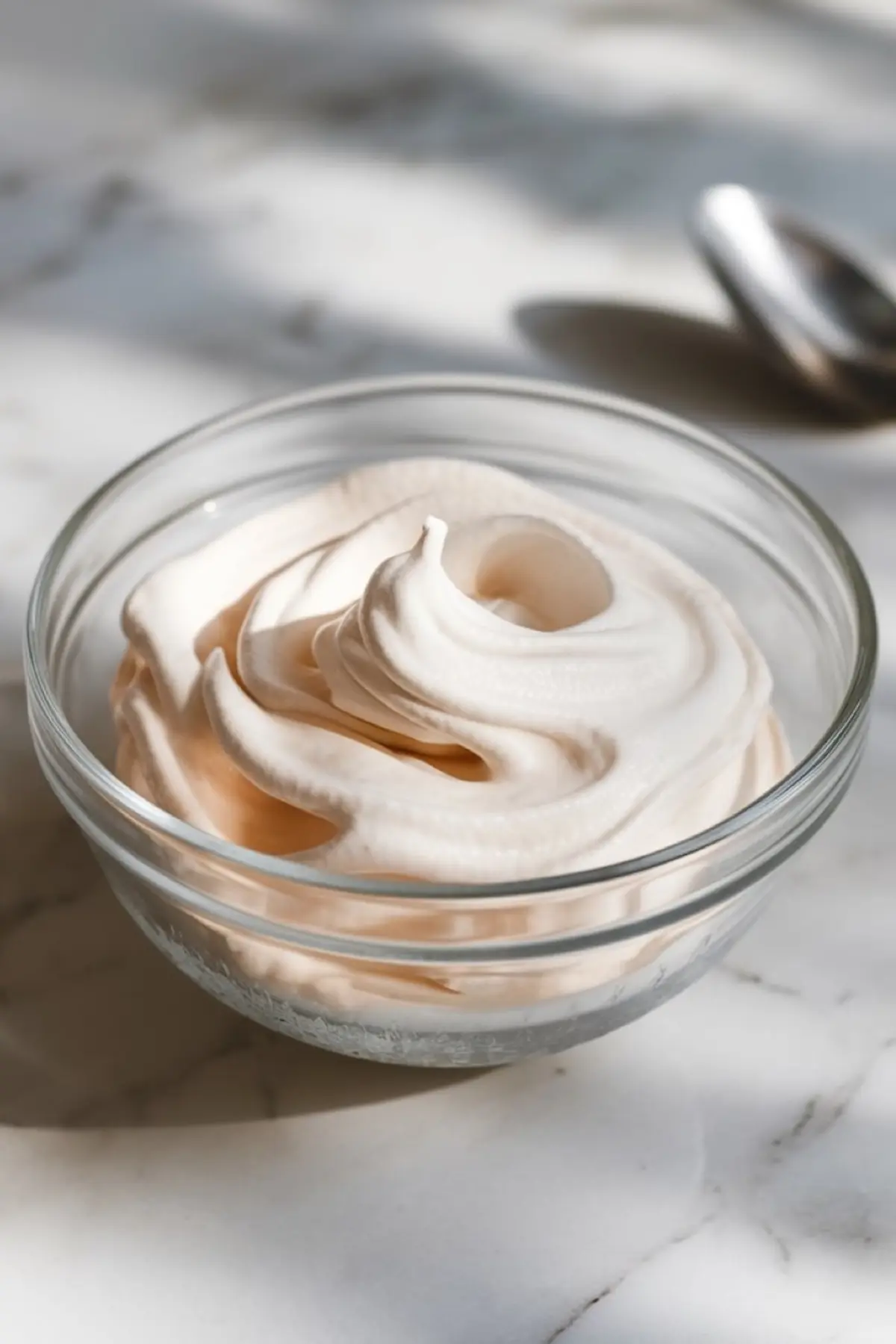
The oven needs to be low—250°F is ideal. The shell crisps while the inside stays soft. You’ll know it’s ready when the exterior feels firm and just slightly golden, not brown.
Once it’s baked, leave it in the oven with the door ajar for an hour. This cool-down prevents the meringue from cracking due to sudden temperature changes. I usually wedge a wooden spoon in the oven door and walk away. Letting it rest this way is key. The shell stabilizes and finishes drying gently.
You can store the unfilled meringue in an airtight container at room temperature for a full day. I wouldn’t refrigerate it—the moisture in the fridge softens the shell too much and steals that satisfying crunch.
Whipping the Cream and Preparing the Peaches for a Balanced Pavlova Topping
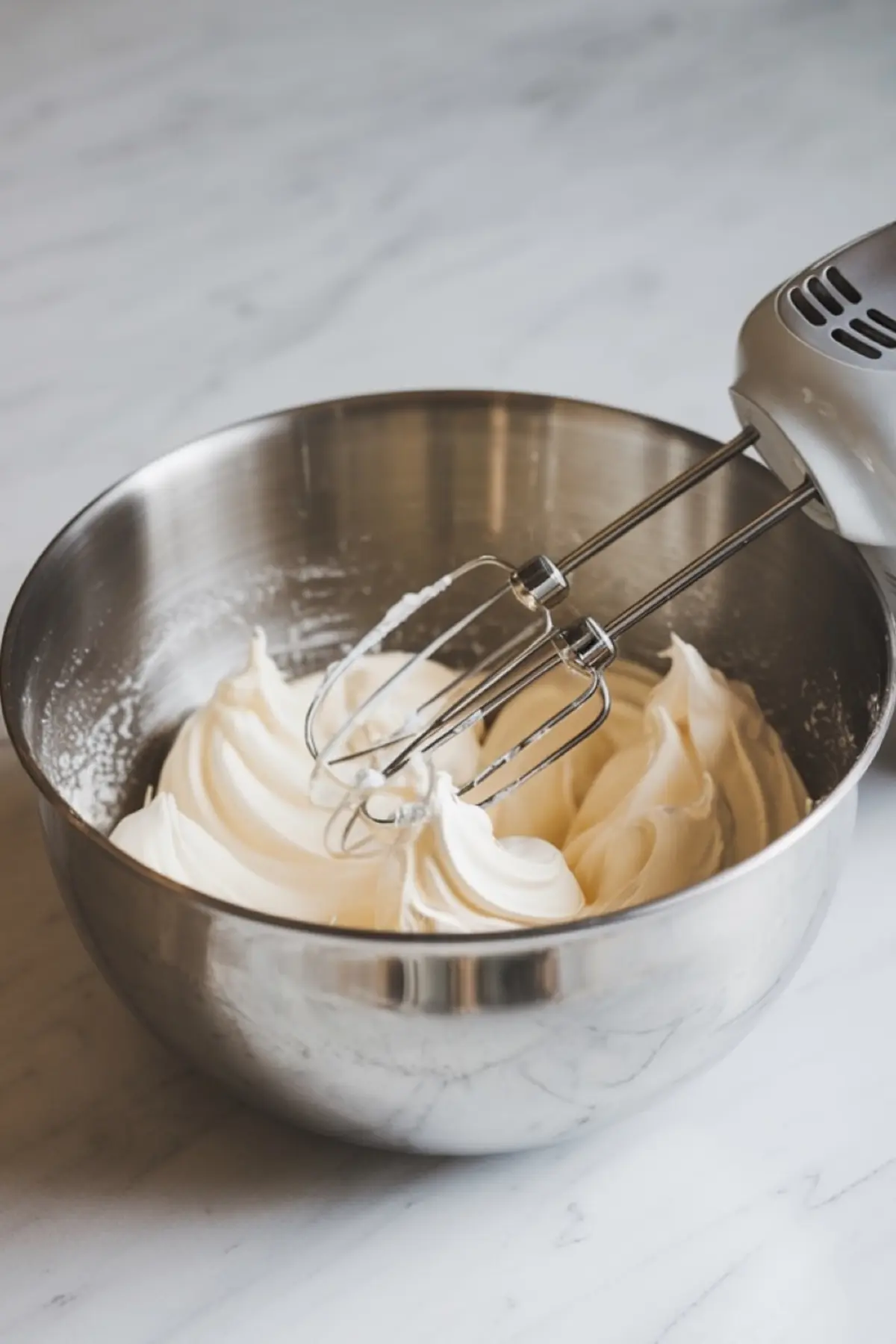
Use cold cream straight from the fridge. Beat it until it forms soft peaks. Add powdered sugar and vanilla near the end, just enough to round out the flavor. It shouldn’t feel dense—it should spread softly and settle into the center of the pavlova like it belongs there.
Choose peaches that are ripe but still firm. If they’re too soft, they’ll slide around and lose shape. Slice them thin. The thinner the slice, the easier it layers and the more elegant it looks. If the fruit feels too juicy, I pat it down lightly with a paper towel before arranging.
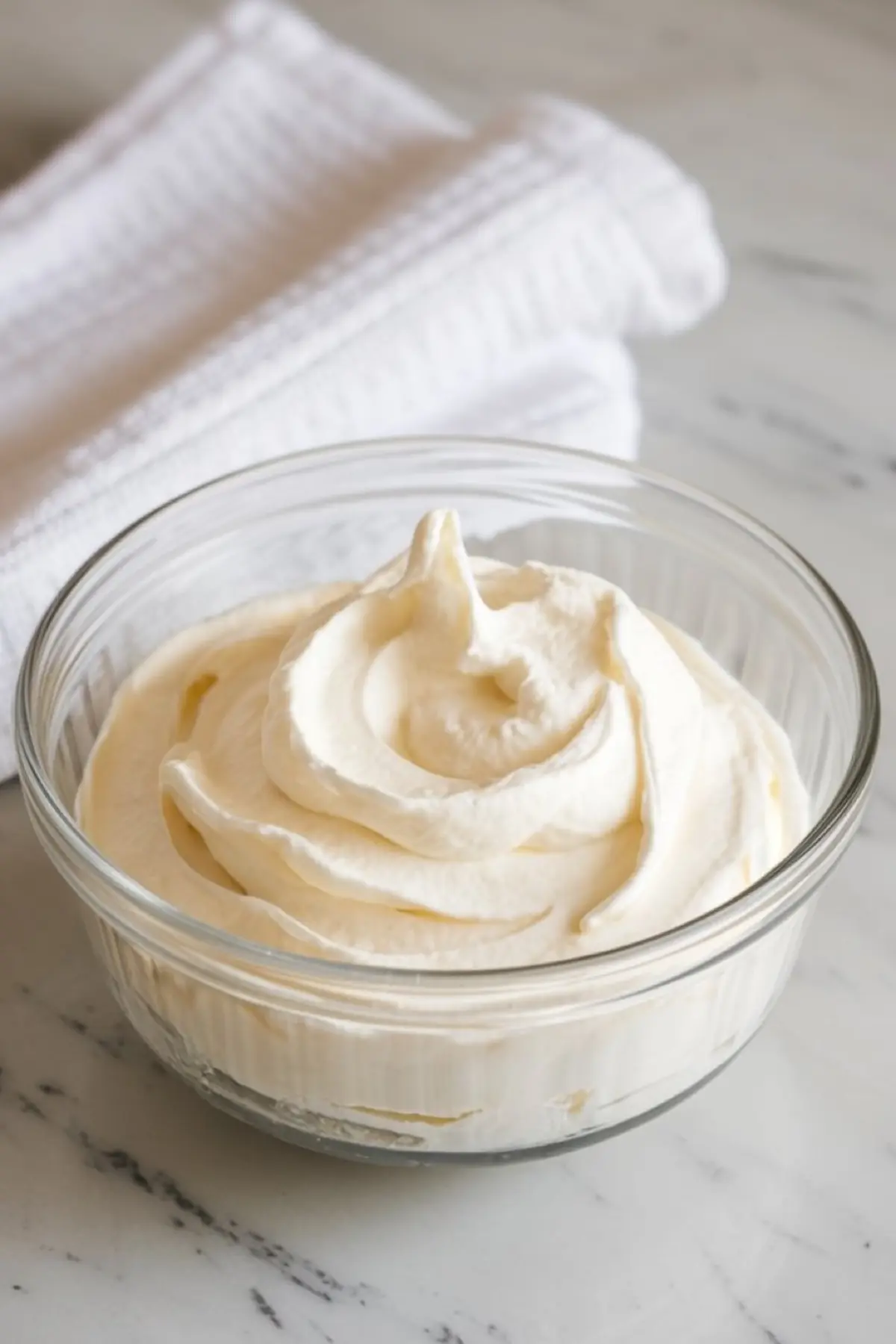
That spiral of peaches? It’s optional, but satisfying. I’ve layered them every which way. What matters more is that the slices nestle into the cream without sliding off.
Drizzling the Honey for Depth and Visual Warmth

Use floral honey like orange blossom or clover. Drizzle it at the very end, just before serving. The warmth of the honey balances the peaches and adds a soft glow across the top of the cream.
Sometimes, I gently warm the honey before using it—it becomes easier to drizzle and creates those beautiful, slow-moving ribbons over the cream. Let it run naturally down the sides. The uneven flow gives the pavlova movement and life on the plate.
You could even swap in raspberry honey or lavender if you want something more floral, though I usually come back to clover. It lets the peaches speak.
Serving and Storing Peach Pavlova with Cream and Honey
Serve the pavlova within an hour after assembling. The contrast between the crisp shell, the whipped cream, and the peaches works best when fresh. If it sits too long, the cream softens the meringue and takes away that texture.
If you want to prep ahead, make the meringue shell a day early and store it in an airtight container. Keep the cream and fruit separate until right before serving.
Leftovers? They exist for about an hour in my house. But if you must store them, refrigerate covered for a few hours. Just know the texture changes, and the meringue softens.
Try These Other Summer Desserts You’ll Love
If this Peach Pavlova speaks to your love of texture and fruit-forward flavor, you’ll probably enjoy my Raspberry Swirl White Chocolate Blondies. They offer a similar balance of sweet and tart, but with a chewy blondie base instead of meringue.
The Raspberry Caramel Millionaire’s Shortbread layers buttery shortbread with rich caramel and sharp berry notes. You can find it here.
Or try something chilled like the Strawberry Shortcake Ice Cream Cake for warmer days. It’s easy to slice and makes an excellent backyard treat. Take a look here.
And if you enjoy nutty flavors, the Pistachio Tart brings something different with its buttery crust and earthy flavor.
Let Me Know How Yours Turned Out—And Save This Recipe for Later

You can pin this Peach Pavlova with Honey Drizzle to your favorite summer desserts board so you can find it when peaches come back in season. If you made it—or plan to—drop a comment below.
Tell me how you sliced your peaches or what honey you used. I always love hearing how others bring their own flavor to these desserts. You’re part of this kitchen, too.
Peach Pavlova with Honey Drizzle Recipe

Crisp meringue, soft whipped cream, ripe summer peaches, and golden honey create a balanced, textural dessert. The pavlova bakes into a pale golden shell with a marshmallow-soft interior, topped with lightly sweetened cream and fresh fruit. The honey adds warmth and floral depth.
Ingredients
- FOR THE MERINGUE BASE
- 4 large egg whites (room temperature)
- 1 cup (200g) caster sugar (superfine)
- 1 ½ tsp cornstarch
- 1 tsp white vinegar or lemon juice
- 1 tsp vanilla extract
- FOR THE TOPPING
- 1 cup heavy whipping cream (cold)
- 2 tbsp powdered sugar
- ½ tsp vanilla extract
- 2–3 ripe peaches, thinly sliced
- 2–3 tbsp honey (preferably a floral variety like orange blossom or clover)
Instructions
- PREP AND PREHEAT: Preheat the oven to 250°F (120°C). Line a baking sheet with parchment paper. If desired, trace a 7-inch circle on the underside of the paper to use as a guide when shaping the meringue.
- MAKE THE MERINGUE: In a clean, grease-free mixing bowl, whip the egg whites on medium speed until soft peaks form. Gradually add the caster sugar, one tablespoon at a time, continuing to beat for about 10 minutes until the mixture is thick and glossy. Add the cornstarch, vinegar, and vanilla extract, then gently fold with a spatula until fully incorporated.
- SHAPE AND BAKE: Spoon the meringue into the center of the parchment circle and shape it into a tall disk with slightly raised edges, forming a shallow bowl. Bake for 1 hour and 15 minutes, or until the outside is crisp and a pale golden ivory. Turn off the oven and leave the door slightly ajar. Allow the pavlova to cool completely inside the oven for about 1 hour to prevent cracking.
- WHIP THE CREAM: Just before serving, whip the heavy cream with powdered sugar and vanilla extract until soft peaks form.
- ASSEMBLE: Carefully transfer the cooled meringue to a serving plate. Spoon the whipped cream into the center. Arrange the peach slices on top in a spiral or overlapping pattern. Drizzle generously with honey, allowing it to flow naturally over the cream and down the sides of the meringue.
Notes
Use room temperature egg whites for the most stable meringue. Cold whites won’t whip as well and may result in a flatter structure. Make sure your mixing bowl and beaters are completely clean and free of grease—any residue can prevent the whites from reaching full volume. Caster sugar (superfine sugar) dissolves more quickly and evenly into the meringue; avoid granulated sugar if possible, as it can lead to a grainy texture. Add the sugar slowly, one tablespoon at a time, to allow it to fully incorporate and create a glossy finish.
Cornstarch and vinegar (or lemon juice) help stabilize the meringue’s interior, giving it a marshmallow-like center with a crisp outer shell. Fold these in gently to avoid deflating the volume you’ve built up during whipping.
To shape the pavlova, use a spoon or offset spatula to create a wide, shallow bowl with higher edges. This helps hold the cream and fruit topping later and gives the dessert its signature look. Don’t worry about making it perfectly symmetrical—those rustic swirls and peaks add visual appeal once baked.
The baking process is key: a low oven temperature allows the outside to dry and set without browning, while the inside stays soft. Turning off the oven and letting the pavlova cool slowly with the door slightly open minimizes cracking, which can occur with sudden temperature changes.
Whip the cream just until soft peaks form to keep it light and easy to spread. Overwhipped cream becomes stiff and can overpower the delicate texture of the meringue.
Use ripe but firm peaches so they slice cleanly and hold their shape on top of the whipped cream. Thin slices create a more refined presentation and make it easier to portion. If your peaches are extra juicy, pat them dry slightly before layering to prevent excess moisture from seeping into the cream.
Drizzle the honey right before serving so it stays fresh and visually vibrant. Floral honeys like clover or orange blossom enhance the fruit without overwhelming it. For extra flavor, try warming the honey slightly to make it easier to drizzle.
Assembled pavlova is best served within an hour to preserve the contrast between the crisp meringue and soft toppings. If needed, you can prepare the meringue shell a day in advance and store it in an airtight container in a cool, dry place. Avoid refrigeration, which introduces humidity and can soften the shell.
Nutrition Information
Yield
8Serving Size
1Amount Per Serving Calories 511Total Fat 12gSaturated Fat 7gTrans Fat 0gUnsaturated Fat 4gCholesterol 34mgSodium 40mgCarbohydrates 104gFiber 8gSugar 97gProtein 7g

